Chakin and Chasen in Offerings
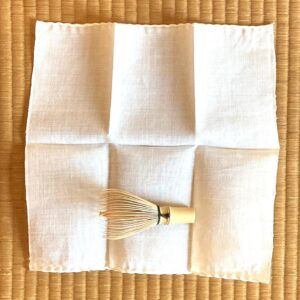
Cha-sen, 茶筅, tea-whisk, take, 竹, bamboo, L. 3.8 sun kane-jaku, or 3 sun kujira-jaku.
Shin cha-kin, 真茶巾, true tea-cloth, asa, 麻, hemp; 8 x 8 sun kujira-jaku. A new chakin prepared for purchase is folded in half and then folded in thirds.
Bamboo artisans traditionally use the kane-jaku, 曲尺, bend-span, which equals 12 inches or 30.3 cm, and that weavers traditionally use the kujira-jaku, 鯨尺, whale-span, which equals 15 inches or 38 cm.
The measurement of the chakin is 8, which, when divided by 3, is 2.666 to infinity. The number 6, in Japanese is roku, 六, which is symbolic of mizu, 水, water and Infinity in Time.
The measurement of 2.666 compared to the measurement of the chasen, 3 sun, is .888 to infinity. The number 8 in Japanese is hachi, 八, which is symbolic of Infinity in Space.
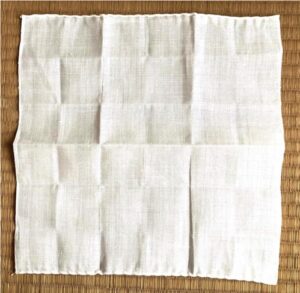
To prepare the chakin for use, it is immersed in water, and wrung damp, and then folded in half, then folded in thirds horizontally, then folded in thirds. In the photograph above, the chakin shows the folds created when it is folded six times. Note that folding the chakin creates four squares of nine squares, which is a total of thirty-six squares. Each of the nine-square squares resembles the Kon-gō-kai man-da-ra, 金剛界曼荼羅, Gold-strength-realm wide-weed-spread, that depicts the myriad deities in the Buddhist world.
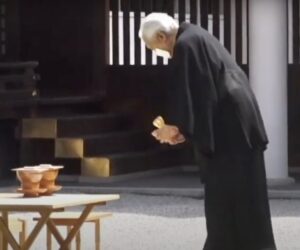
Dai-sō-shō Sen Gen-shitsu, 大宗匠千玄室, Great-sect-artisan Thousand Mystery-room, age 99, bowing with cha-sen, 茶筅, tea-whisk, cha-kin, 茶巾, tea-cloth, on a sen-zara, 筅皿, whisk-dish, beginning a Ken-cha-shiki, 献茶式, Offer-tea-rite, at Nishi-no-miya Jin-ja, 西宮神社, West-palace God-shrine.
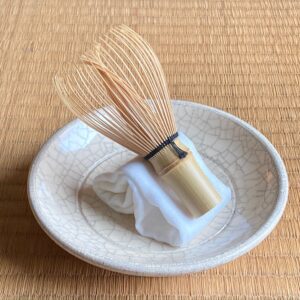
The shape of the bamboo chasen suggests a triangle, the shape of the hemp chakin is a square, and the shape of the ceramic sen-zara, 筅皿, whisk-dish, is a circle. These shapes together, are the basic symbols of all life forms.
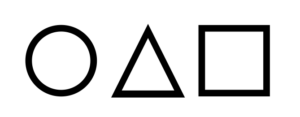
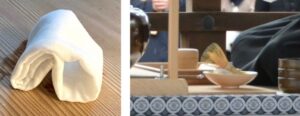
Shin cha-kin, 真茶巾, true-tea-cloth, folded for use. In the photograph on the right, the cha-sen, 茶筅, tea-whisk, is resting on the cha-kin, 茶巾, tea-cloth, supported on a white ceramic sen-zara, 筅皿, whisk-dish, which is part of the Ken-cha-shiki, 献茶式, Offer-tea-rite, at a Shintō Jin-ja, 神社, God-shrine. Note the plain wood natsume, 棗, jujube, tea container, and plain wood naga-bon, 長盆, long-tray

According to the I Ching, Eki-kyō, 易経, Change-sutra, hexagram, 36 is Chi-ka Mei-i, 地火明夷, Earth-fire Bright-obscure.
The lower trigram ☲ is Ri, 離, Detach, is symbolic of Fire, and the upper trigram ☷ is Kon, 坤, land, is symbolic of Earth.
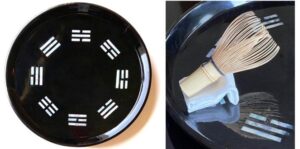
Ha-kke bon, 八卦盆, eight-divination sign tray, black lacquered round tray with ao-gai, 青貝, blue-shell, inlay designs of the eight trigrams of the Eki-kyō, 易経, Change-sutra. The trigram for Ri, ☲, is at the bottom of the tray, South, and the trigram for Kon, ☷, is located lower left on the tray, Southwest.

Fine chakin are made of hon-asa, 本麻, original-hemp, called Na-ra sarashi, 奈良晒, What-good bleached. Some chakin have the cut edges hemmed and sewn to resemble take-fushi, 竹節, bamboo-nodes. The stitching of the chakin edges resemble somewhat the thread that is plaited around the chasen that helps to keep separate the outer tines.
The circumference of the standard chasen is 2 sun kujira-jaku. The width of the standard chakin is 8 sun kujira-jaku.
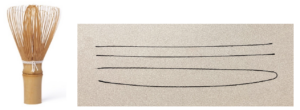
Kagarai ito, カガリ糸, 縢り糸, braid-thread, unwound from a chasen. The length of two threads is 8 sun kane-jaku, the length of the doubled thread is 16 sun kane-jaku. Collectively, the threads are braided around the chasen three times. The threads of the chasen and the threads of the take-fushi chakin relate to each other 8:10.
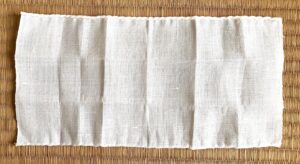
Cha-kin, 茶巾, tea-cloth, asa, 麻, hemp; 8 x 4 sun kujira-jaku. The cut edges are rolled and hemmed in opposite directions: the bottom edge is rolled back establishing the shō-men, 正面, correct-face. The original folds dividing the chakin in thirds are prominent. Note, from the left, the secondary folds in squares 2 and 5.
The chakin displayed on the Hakke bon is half the length of the shin chakin, the half length chakin is the size most often used in Chanoyu. The damp chakin is folded horizontally into thirds, then folded in half, and folded in half again, then one-third is folded creating a square. This folding creates eighteen squares, and in Japanese this is jū-hachi, 十八, ten-eight. These two Kanji can create the Kanji, moku, ki, 木, wood, tree, which is symbolic of ‘life’. Note that there are two squares of nine squares, which also may evoke the Kongōkai mandara.
By unfolding and refolding the chakin, it is easy to think of the item as a single piece of cloth whereas it is important to remember that both sides of the cloth are folded and ultimately refolded. With this in mind, the standard rectangular chakin more closely approximates the thirty-six squares of the full square shin chakin.
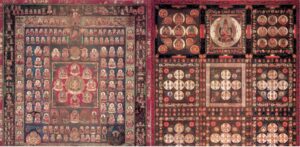
In certain informal Tea presentations, the standard rectangular chakin is unfolded, turned over and refolded in the same manner, in the presence of the guests. This action causes the chakin to reveal both sides and may show the guest the actual physical aspects of the chakin, and perhaps reveal its possible connections with the Ryō-kai Man-da-ra, 両界曼荼羅, Both-worlds Wide-weed-spread.
During a few more formal Tea presentations, the chakin is also unfolded and refolded in the presence of the guests. This action may show the guest the actual physical aspects of the chakin, and perhaps reveal its possible connections with the Ryō-kai Man-da-ra, 両界曼荼羅, Both-worlds Wide-weed-spread. Both mandalas are based on groupings of nine deities. Those squares that form a cross ✚ are usually supreme Buddhas, whereas those in the corners are of lesser stature, but still of major importance and may be Bo-satsu, 菩薩, Grass-buddhas, buddhas in transition, or consorts of the Buddhas.
It is relevant to know that the cardinal directions are such that both mandalas are joined at the West direction. Although the two mandalas are displayed side by side, in fact, they are the two sides on a single object. The object may be likened to the fukusa used by the host of a Tea presentation to purify certain utensils.
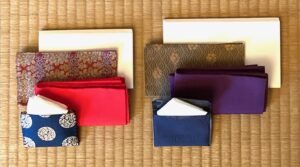
Left: fabric and paper utensils generally for women; Right: utensils generally for men. Red, aka, 赤, is a Yō / Yang color to complement the feminine In / Yin, and purple, murasaki, 紫, is an In color to complement the masculine Yō.
Each guest should have a fuku-sa, 帛紗, cloth-gauze, ko-buku-sa, 古帛紗, small fukusa, kai-shi, 懐紙, heart-paper, and a ko-ja-kin, 小茶巾, small-tea-cloth, which is the same as the standard chakin, but smaller: 4 x 6 sun kane-jaku. In modern times, kami ko-cha-kin, 紙小茶巾, paper small-tea-cloth, have become a replacement for the hemp or linen ones. Quite often in class, a sheet of kaishi is used to wipe the chawan, which may have been the original, and later, used a hemp, linen, or cotton chakin. The damp kami kojakin is used to wipe the rim of the chawan after drinking koi-cha, 濃茶, thick-tea, as the bowl of tea is usually shared with others. The kojakin is kept in a small envelope called a chakin basami, 挟み, folder, which may be made of fine fabric and lined in take-no-kawa, 竹の皮, bamboo-’s-skin. These articles are kept in the front folding of the kimono, futokoro, 懐, which is close and dear to the heart.
For further study, see also: Buddha’s Gems: Chakin and Chanoyu, Chakin and Lotus, and Hakobi Tenmae: Carrying Fire

